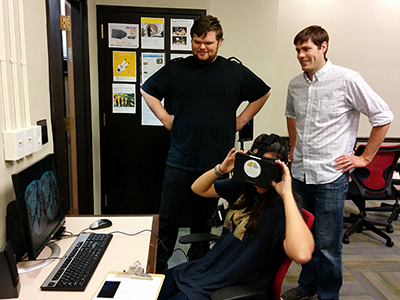
Faculty and students create virtual reality simulations to prepare Cincinnati Children’s Hospital Neonatal Unit in disaster response
Written by Ivy Shtull, CAS communications intern
It was just three years ago that Hurricane Sandy took the East Coast by storm, literally, and Sherry Farra recognized a need for better disaster readiness in healthcare settings. At the time, Farra was an associate professor in Miami’s nursing program who has since moved on to Wright State’s College of Nursing and Health.

Marcus Holm, Ivy Shtull, and Eric Hodgson (left to right) in Miami's Smale Interactive Visualization Center
After the Category 3 major hurricane ignited Farra's already strong focus in disaster preparedness, she began working with Eric Hodgson, who currently is a visiting assistant professor in interactive media studies (IMS) and the director of Miami's Smale Interactive Visualization Center.
Before long, the study entitled Effects of Virtual Reality Simulation on Worker Emergency Evacuation of Neonates was born.
"We had gotten to talking and she was really interested in building virtual reality simulations that could recreate a fire or a tornado or radiation exposure or whatever and build these situations where nursing students could practice responding," said Hodgson.
After creating an initial computer simulation of a plane crash site, and several others involving radiation exposure and decontamination, Farra and Hodgson decided to aim their project at practicing evacuation exercises.
"With Hurricane Sandy, everyone kind of knew the storm was coming…and they knew it was going to be bad," said Hodgson. "There was a neonatal unit in a children's hospital in New York that didn't want to move the babies because premature babies are very fragile. They're not the kind of patient you want to move to a different hospital or drive in an ambulance."
Hodgson explained that the hospital decided to rely on their backup generators. However, Hurricane Sandy caused unexpected severe flooding, which left nurses scrambling and improvising in the wake of the crisis. New York University Langone Medical Center was forced to evacuate 20 NICU babies.
"They were really unprepared for it," said Hodgson. "Looking at that, it was like 'what can we do regionally with the Cincinnati Children's Hospital to prepare our nurses to evacuate these babies if they ever need to.'"
A multi-year, multi-institutional project
The Effects of Virtual Reality Simulation on Worker Emergency Evacuation of Neonates project is funded through the Agency for Healthcare Research and Quality (AHRQ), a joint effort among Miami, Wright State, University of Cincinnati, and the Cincinnati Children's Hospital.

Screen capture from virtual reality training scenario
The virtual reality training scenarios start off easy, giving the nurse the responsibility of one stable patient. As the nurse continues, the scenarios get harder and harder as they are put in charge of multiple patients with varying degrees of specialized care and increasingly difficult environments.
The first scenario is set to be completed in the next few weeks, and Hodgson and his team of three Miami students, Marcus Holm, Michael Sosan, and Lauren McKenzie, hope to finish the rest of them by the end of summer. Student Brian Neibecker also made significant contributions during the 2014-2015 academic year.
Next February, Cincinnati Children's Hospital neonatal unit will undergo a live evacuation drill with medical mannequins and then embark on both traditional website training and the new virtual scenarios to compare their effectiveness. By the beginning of 2017, a second live evacuation drill will hopefully show significant improvement.
Students' work in the virtual reality lab
Hodgson believes the quality of his students' work in the lab has been the highlight of this project, and the students have found it to be a rewarding experience.
"It was really cool to have people at Cincinnati Children's Hospital just appreciate the fact that this project is being done," said senior Marcus Holm, an IMS major with a minor in computer science. "I make something for a class and I get a grade, but I don't get people who are just genuinely happy that I made something."
"Coming from a traditional computer science background, it was very different," added Michael Sosan, a junior majoring in computer science and co-majoring in IMS. "It's a good learning experience and I'll definitely end up using it when I'm working on future projects."
"Part of the challenge is to build these virtual evacuation exercises, and another part is to evaluate the new technology," said Hodgson. He believes it has the potential to change the approach to not only healthcare training but also to various areas of education.
"Virtual training and education is a really growing field, and building these scenarios is kind of breaking new ground," he said.
"I've learned that the virtual reality field is a lot larger than I thought," said junior Lauren McKenzie, an English major/IMS co-major. "There are a lot of opportunities, and it involves just about everything."